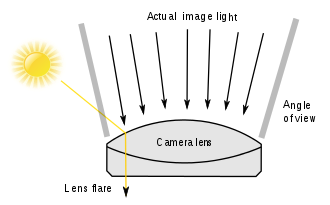Lens flare
Lens flare is a phenomenon that occurs when light is scattered or flared in a lens system, often in response to a bright light source, such as the Sun or artificial lighting. This effect is typically seen in photography and cinematography and can be either an unwanted artifact or a deliberate artistic choice.
Causes
Lens flare is caused by the reflection and scattering of light within the lens elements and the camera body. When light enters the lens, it can reflect off the surfaces of the lens elements and the aperture blades, creating multiple reflections that manifest as visible artifacts. These artifacts can take the form of bright spots, rings, or streaks of light.
Types of Lens Flare
There are two primary types of lens flare:
- Specular Flare: This type of flare appears as distinct, often circular, bright spots or rings. It is caused by direct reflections of the light source within the lens.
- Veiling Flare: This type of flare appears as a haze or reduction in contrast across the image. It is caused by scattered light that reduces the overall image quality.
Factors Influencing Lens Flare
Several factors can influence the occurrence and appearance of lens flare:
- Lens Design: The number of lens elements, their coatings, and the overall design can affect the likelihood of flare.
- Aperture Settings: Smaller apertures (higher f-numbers) can reduce the intensity of lens flare, while larger apertures (lower f-numbers) can increase it.
- Light Source Position: The position and intensity of the light source relative to the lens can significantly impact the presence of flare.
- Lens Coatings: Modern lenses often have anti-reflective coatings that help to minimize flare.
Mitigation Techniques
Photographers and cinematographers can use several techniques to reduce or control lens flare:
- Lens Hoods: Using a lens hood can block stray light from entering the lens, reducing the likelihood of flare.
- Positioning: Changing the angle or position of the camera relative to the light source can help to avoid flare.
- Post-Processing: Digital editing software can be used to reduce or remove lens flare artifacts in post-production.
Artistic Use of Lens Flare
While lens flare is often considered an unwanted artifact, it can also be used creatively to enhance the visual appeal of an image or scene. In cinematography, lens flare can add a sense of realism or drama, and it is sometimes deliberately introduced to achieve a specific aesthetic effect.
See Also
References
Transform your life with W8MD's budget GLP-1 injections from $125.
W8MD offers a medical weight loss program to lose weight in Philadelphia. Our physician-supervised medical weight loss provides:
- Most insurances accepted or discounted self-pay rates. We will obtain insurance prior authorizations if needed.
- Generic GLP1 weight loss injections from $125 for the starting dose.
- Also offer prescription weight loss medications including Phentermine, Qsymia, Diethylpropion, Contrave etc.
NYC weight loss doctor appointments
Start your NYC weight loss journey today at our NYC medical weight loss and Philadelphia medical weight loss clinics.
- Call 718-946-5500 to lose weight in NYC or for medical weight loss in Philadelphia 215-676-2334.
- Tags:NYC medical weight loss, Philadelphia lose weight Zepbound NYC, Budget GLP1 weight loss injections, Wegovy Philadelphia, Wegovy NYC, Philadelphia medical weight loss, Brookly weight loss and Wegovy NYC
|
WikiMD's Wellness Encyclopedia |
| Let Food Be Thy Medicine Medicine Thy Food - Hippocrates |
Medical Disclaimer: WikiMD is not a substitute for professional medical advice. The information on WikiMD is provided as an information resource only, may be incorrect, outdated or misleading, and is not to be used or relied on for any diagnostic or treatment purposes. Please consult your health care provider before making any healthcare decisions or for guidance about a specific medical condition. WikiMD expressly disclaims responsibility, and shall have no liability, for any damages, loss, injury, or liability whatsoever suffered as a result of your reliance on the information contained in this site. By visiting this site you agree to the foregoing terms and conditions, which may from time to time be changed or supplemented by WikiMD. If you do not agree to the foregoing terms and conditions, you should not enter or use this site. See full disclaimer.
Credits:Most images are courtesy of Wikimedia commons, and templates, categories Wikipedia, licensed under CC BY SA or similar.
Translate this page: - East Asian
中文,
日本,
한국어,
South Asian
हिन्दी,
தமிழ்,
తెలుగు,
Urdu,
ಕನ್ನಡ,
Southeast Asian
Indonesian,
Vietnamese,
Thai,
မြန်မာဘာသာ,
বাংলা
European
español,
Deutsch,
français,
Greek,
português do Brasil,
polski,
română,
русский,
Nederlands,
norsk,
svenska,
suomi,
Italian
Middle Eastern & African
عربى,
Turkish,
Persian,
Hebrew,
Afrikaans,
isiZulu,
Kiswahili,
Other
Bulgarian,
Hungarian,
Czech,
Swedish,
മലയാളം,
मराठी,
ਪੰਜਾਬੀ,
ગુજરાતી,
Portuguese,
Ukrainian
Contributors: Prab R. Tumpati, MD





